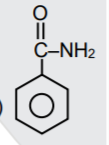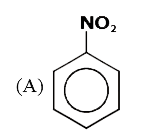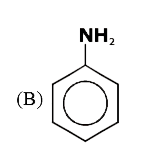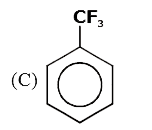Which of the following can give highest yield in Friedel craft reaction?




The correct Answer is:B
To determine which of the given options can provide the highest yield in a Friedel-Crafts reaction, we need to analyze the electron-donating or withdrawing effects of the substituents on the benzene ring. The Friedel-Crafts reaction requires a high electron density on the aromatic ring to facilitate electrophilic substitution.
1. Understanding Friedel-Crafts Reaction:
- The Friedel-Crafts reaction is an electrophilic aromatic substitution reaction that requires a strong electrophile and a benzene ring with high electron density.
- The presence of electron-donating groups (EDGs) increases the electron density on the benzene ring, making it more reactive towards electrophiles.
2. Analyzing the Substituents:
- Option 1: NH2 (Amino group):
- The amino group is an electron-donating group due to its lone pair of electrons. However, it can also act as a Lewis base and react with the Lewis acid (AlCl3), leading to an acid-base reaction rather than an electrophilic substitution.
- Option 2: OH (Hydroxyl group):
- Similar to the amino group, the hydroxyl group also donates electron density but can also behave as a Lewis base, leading to potential acid-base interactions with AlCl3, thus not favoring the Friedel-Crafts reaction.
- Option 3: Cl (Chloro group):
- The chloro group is a weak electron-withdrawing group (due to -I effect) but does not significantly decrease electron density compared to the amino and hydroxyl groups. It does not participate in acid-base reactions with AlCl3.
- Option 4: CONH2 (Amide group):
- The amide group has a strong -M (minus mesomeric) effect, which decreases electron density on the benzene ring significantly, making it less reactive in Friedel-Crafts reactions.
3. Comparing the Options:
- The first two options (NH2 and OH) are not suitable due to their Lewis base behavior.
- The fourth option (CONH2) decreases electron density significantly due to its strong -M effect.
- The third option (Cl) is the least electron-withdrawing and does not interfere with the Friedel-Crafts reaction, thus allowing for a higher yield.
4. Conclusion:
- Therefore, the option that can give the highest yield in the Friedel-Crafts reaction is Option 3: Cl (Chloro group).
Final Answer:
Option 3: Cl (Chloro group)
- The Friedel-Crafts reaction is an electrophilic aromatic substitution reaction that requires a strong electrophile and a benzene ring with high electron density.
- The presence of electron-donating groups (EDGs) increases the electron density on the benzene ring, making it more reactive towards electrophiles.
- Option 1: NH2 (Amino group):
- The amino group is an electron-donating group due to its lone pair of electrons. However, it can also act as a Lewis base and react with the Lewis acid (AlCl3), leading to an acid-base reaction rather than an electrophilic substitution.
- Option 2: OH (Hydroxyl group):
- Similar to the amino group, the hydroxyl group also donates electron density but can also behave as a Lewis base, leading to potential acid-base interactions with AlCl3, thus not favoring the Friedel-Crafts reaction.
- Option 3: Cl (Chloro group):
- The chloro group is a weak electron-withdrawing group (due to -I effect) but does not significantly decrease electron density compared to the amino and hydroxyl groups. It does not participate in acid-base reactions with AlCl3.
- Option 4: CONH2 (Amide group):
- The amide group has a strong -M (minus mesomeric) effect, which decreases electron density on the benzene ring significantly, making it less reactive in Friedel-Crafts reactions.
- The first two options (NH2 and OH) are not suitable due to their Lewis base behavior.
- The fourth option (CONH2) decreases electron density significantly due to its strong -M effect.
- The third option (Cl) is the least electron-withdrawing and does not interfere with the Friedel-Crafts reaction, thus allowing for a higher yield.
- Therefore, the option that can give the highest yield in the Friedel-Crafts reaction is Option 3: Cl (Chloro group).
Option 3: Cl (Chloro group)
Similar Questions
Knowledge Check
Which of the following compound gives poor yield in friedel-craft reaction
A B
B C
C DAll of these
DAll of theseWhich of the following can be used in Friedel Crafts acylation reactions ?
ACH3COOCH3BCH3CH2COClCCH3CH2ClD(CH3CO)2OWhich of the following can be used in Friedel Crafts reaction when benzene used with AlCl3
A BCH2=CH–ClCCH3CH2ClDCH2=CH–CH2–Cl
BCH2=CH–ClCCH3CH2ClDCH2=CH–CH2–Cl
Which of the following compound will not give Friedel-Crafts reaction?
View SolutionWhich of the following compounds do not give Friedel Crafts reaction?
View SolutionWhich of the following is used in Friedel Craft acetylation reaction
View SolutionWhich of the following compounds will not gives Friedel-Cafts reaction ?
View SolutionWhich of the following is used as a solvent in the Friedel-Crafts reaction :-
View Solution
